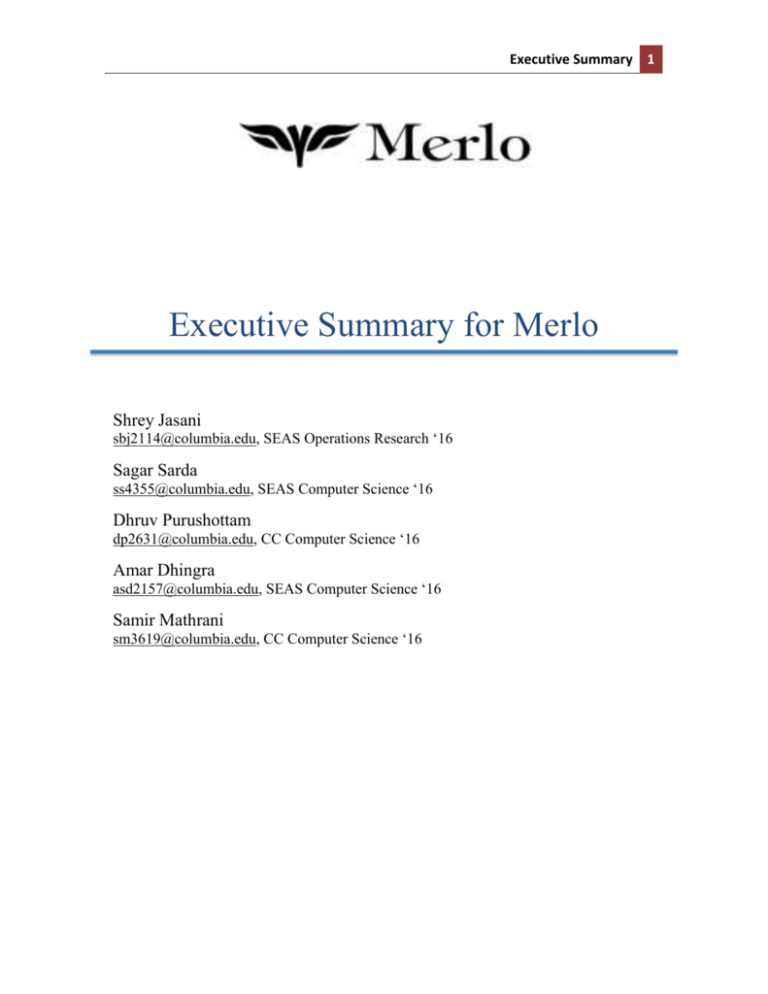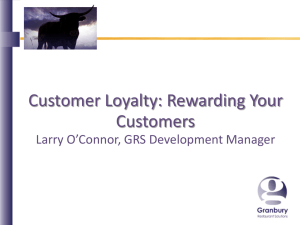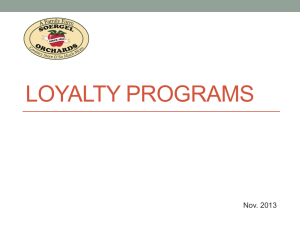Executive Summary for Merlo
advertisement

Executive Summary 1 Executive Summary for Merlo Shrey Jasani sbj2114@columbia.edu, SEAS Operations Research ‘16 Sagar Sarda ss4355@columbia.edu, SEAS Computer Science ‘16 Dhruv Purushottam dp2631@columbia.edu, CC Computer Science ‘16 Amar Dhingra asd2157@columbia.edu, SEAS Computer Science ‘16 Samir Mathrani sm3619@columbia.edu, CC Computer Science ‘16 2 EXECUTIVE SUMMARY MERLO APP As the world is going digital, why are loyalty programs left behind? Merlo App solves this problem for both consumers and retail stores. Merlo is an app that allows a devotee of Joe’s coffee to be rewarded loyalty points for every coffee purchase at Joe’s. We take existing loyalty schemes offered by stores that still use paper or plastic cards and make them digital, which is both cheap and efficient for stores. Moreover, we extend data analytics services to allow stores to target specific categories of consumers at specific periods of time. The Industry We Are Targeting Merlo will be built to serve local shops with a community centric approach. We will reach local restaurants, grocers, farmers markets, barbershops, opticians and retail outlets in the Greater New York City area. By creating local networks of Merlo-run shops, we aim to completely take loyalty into a digital dimension. Our first target is the Columbia community, where we have a competitive advantage as students. We believe that Columbia centric local businesses should be able to target students directly. So by offering time elapsing loyalty points, group discounts and deals, these stores could use Merlo to attract new customers. Furthermore, Customer Problem The current organization of the industry is rather problematic. Loyalty programs are managed via paper cards or plastic cards by local shops. Paper cards are cheap costing a shop about $40 - $60 in a year. Customers who then lose interest in the loyalty program continually lose them. Moreover, on average each American household has about 18 to 20 paper cards, which is an unnecessary hassle to manage. Stores also do not derive the full benefit of a loyalty program with paper cards because they are unable to collect data on usage and purchasing patterns of their customers. On the other hand, plastic cards are significantly more expensive costing a shop in the range of $800 - $1000 in a year. These are swipe cards that are issued by stores, who can now collect data on customer patterns. They are partially more convenient, but customers still find their wallets cluttered by many of these plastic cards. Executive Summary 3 Enter Merlo’s slick Technology Merlo, a free app, will have a simple User Interface with the two options for a Facebook or email based sign in for customers. This would be Merlo’s point of user data collection without creating privacy concerns for customers. Signing on will give the customer geolocation based access to local shops around them that are “Merlo-friendly” (i.e., use Merlo to extend loyalty benefits). The app has an in-built QR code scanner that scans a “merchant tag” which is the unique QR code given to each local shop that is “Merlofriendly”. At the point of sales or checkout, the customer scans the “merchant tag”. A loyalty point is recorded on the customer’s account. The beauty of Merlo is that it does not require a point-of-sales integration, which is an expensive process that local stores largely avoid. The store can structure its own loyalty scheme and Merlo can easily digitize it at very low cost and zero hassle. Businesses that wish to join Merlo will receive a basic toolkit for signing up with us. Marketing Our marketing strategy is part of our unique way of doing business. To grow our network quickly, we plan on making our initial local businesses partners in promoting Merlo. In return for offering them very subsidized signup on to Merlo’s loyalty programs, we will take marketing space in each of our partners’ shops and enabling them to urge our customers into joining Merlo to collect loyalty points. This will enable us to grow exponentially and create a network effect. Scalability is the main reason loyalty programs in the past have found it difficult to grow. Our plan of using each merchant we sign to help us acquire more customers, who would then help us acquire more merchants is our way to create network effects for our business. Competition The move from paper/plastic card loyalty to digital has been a slow one. The major competitors in this area are Belly and Pirq. However, both have been slow, given their time, in developing the user base. Part of the reason has been the difficulty in scalability of the business. However, our marketing strategy of including local shops as marketing partners will go a long way in scaling the business and fighting competition. The second reason that they have not gained the same traction is that both platforms require point-of sales integration with the store, which is something we will avoid. This is our competitive advantage. Revenue Mission 4 EXECUTIVE SUMMARY MERLO APP Our base fees are $25, which is a flat fee in order to cover operational expenses. At the start, we will not raise revenue at the expense of losing potential clients. However, the future goal would be to charge a fixed percentage from subscribers on all the new customers or increased sales that were created by Merlo. This will help us generate sustainable revenue rather than flat fees. Managing Costs Since we start lean and have our operational costs covered through signups, our costs will only include server cost and some marketing costs. The Team and our Product The team consists of 5 members at the moment. We have 1 member in business development and 4 in product development. Merlo is currently in alpha phase and we have begun testing the software already. -----End of Executive Summary-----









